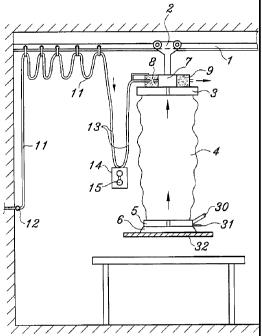Some of the information on this Web page has been provided by external sources. The Government of Canada is not responsible for the accuracy, reliability or currency of the information supplied by external sources. Users wishing to rely upon this information should consult directly with the source of the information. Content provided by external sources is not subject to official languages, privacy and accessibility requirements.
Any discrepancies in the text and image of the Claims and Abstract are due to differing posting times. Text of the Claims and Abstract are posted:
| (12) Patent: | (11) CA 2250404 |
|---|---|
| (54) English Title: | VACUUM HOISTING DEVICE HAVING A VERTICALLY SUSPENDED LIFTING TUBE |
| (54) French Title: | DISPOSITIF DE LEVAGE PNEUMATIQUE COMPRENANT UN TUYAU DE LEVAGE SUSPENDU VERTICALEMENT |
| Status: | Deemed expired |
| (51) International Patent Classification (IPC): |
|
|---|---|
| (72) Inventors : |
|
| (73) Owners : |
|
| (71) Applicants : |
|
| (74) Agent: | NORTON ROSE FULBRIGHT CANADA LLP/S.E.N.C.R.L., S.R.L. |
| (74) Associate agent: | |
| (45) Issued: | 2007-06-12 |
| (86) PCT Filing Date: | 1997-03-26 |
| (87) Open to Public Inspection: | 1997-10-09 |
| Examination requested: | 2002-03-25 |
| Availability of licence: | N/A |
| (25) Language of filing: | English |
| Patent Cooperation Treaty (PCT): | Yes |
|---|---|
| (86) PCT Filing Number: | PCT/SE1997/000545 |
| (87) International Publication Number: | WO1997/036818 |
| (85) National Entry: | 1998-09-28 |
| (30) Application Priority Data: | ||||||
|---|---|---|---|---|---|---|
|
The invention relates to a vacuum hoisting device
of the kind having a vertically suspended lifting tube (4),
which is extensible and contractible in dependence on the
air pressure in the lifting tube, and which at its lower part
is provided with a suction device (6) in the shape of one or
more suction cups. Up to now a valve at the suction device
is used for manoeuvering the suction device, which valve
when closed brings a vacuum source (7, 20) to work with
a constant suction capacity to decrease the pressure in the
lifting tube such that an object (32) to be lifted is attached
by the suction after which the lifting tube is contracted
such that the object is lifted. To limit the lifting height
and to lower and release the object it has been necessary to
partially open the valve and permit a restricted inlet of air
and at last completely open the valve resulting in a large
comsumption of air. According to the invention there is
instead a valve (14, 23) arranged to control the suction
capacity of the vacuum source in direct dependence of
the desired air pressure in the lifting tube (4).
Dispositif de levage pneumatique du type comprenant un tuyau (4) de levage suspendu verticalement qui peut s'étirer et se contracter en fonction de la pression de l'air à l'intérieure du tuyau de levage et qui est équipé au niveau de sa partie inférieure d'un dispositif d'aspiration (6) se présentant sous forme d'une ou plusieurs ventouses. Jusqu'à présent, le système utilisé comprenait une soupape située au niveau du dispositif d'aspiration ou manoeuvrer ce dernier, ladite soupape, lorsqu'elle est fermée, mettant en oeuvre une source (7, 20) de vide avec une capacité d'aspiration constante pour faire baisser la pression dans le tuyau de levage de sorte qu'un objet (32) à lever est maintenu par l'aspiration, le tuyau de levage se contractant ensuite de manière à soulever l'objet. Pour limiter la hauteur de levage et pour faire descendre et relâcher l'objet, il a été nécessaire d'ouvrir partiellement la soupape et de laisser entrer une quantité d'air restreinte pour finir ensuite par ouvrir complètement la soupape ceci ayant pour effet de consommer une grande quantité d'air. Dans cette invention on a remplacé le système précédent par une soupape (14, 23) disposée de manière à réguler la capacité d'aspiration de la source de vide directement en fonction de la pression d'air désirée dans le tuyau (4) de levage.
Note: Claims are shown in the official language in which they were submitted.
Note: Descriptions are shown in the official language in which they were submitted.

For a clearer understanding of the status of the application/patent presented on this page, the site Disclaimer , as well as the definitions for Patent , Administrative Status , Maintenance Fee and Payment History should be consulted.
| Title | Date |
|---|---|
| Forecasted Issue Date | 2007-06-12 |
| (86) PCT Filing Date | 1997-03-26 |
| (87) PCT Publication Date | 1997-10-09 |
| (85) National Entry | 1998-09-28 |
| Examination Requested | 2002-03-25 |
| (45) Issued | 2007-06-12 |
| Deemed Expired | 2010-03-26 |
There is no abandonment history.
Note: Records showing the ownership history in alphabetical order.
| Current Owners on Record |
|---|
| PRONOMIC AB |
| Past Owners on Record |
|---|
| AB INITIO AFFARS- & TEKNIKUTVECKLING |
| WICEN, JAN |